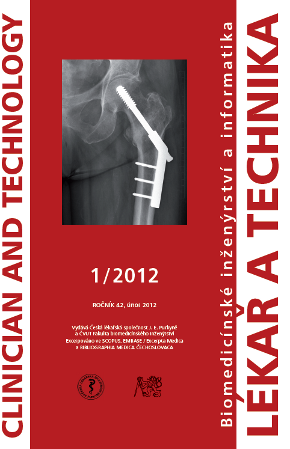RESONANČNÍ METODY MĚŘENÍ VISKOELASTICITY BIOLOGICKÝCH STRUKTUR
Keywords:
viscoelasticity, measurement, complex moduli, mechanical impedanceAbstract
RESONANCE METHODS OF MEASUREMENT VISCOELASTICITY OF BIOLOGICAL STRUCTURES. Dynamic loading is typical for most biological structures. Consequently, mechanical behavior of biological structures cannot be fully described by static parameters and characteristics. Changes in deformation lead to energy losses, furthermore, energy losses are result of existence of viscose constituents in mechanical behavior in biological materials. Bodies in which losses of energy are not negligible belong to category of so called viscoleastic bodies. Viscoelasticity is property of bodies or material that exhibits both viscous and elastic behavior when deformed. From the mathematical point of view, relationships between stresses and strains may be described by adequate differential equation. More practical approach is based on rheological models or, more recently, on determination of complex modules of elasticity, complex dynamic stiff ness and mechanical impedance. Availability of applicable methodology of measurement of viscoelasticity is essential for quantifi cation of mechanical behavior viscoelastic bodies. At present, methodology DMA (dynamic mechanical analysis) is applied for measurement of viscoelasticity industry. The DMA is based on measurement of mechanical frequency characteristics. Methods based on RMA (resonance mechanical analysis) are designated for measurements in biomechanical and biomedical laboratories.Downloads
Published
Issue
Section
License
Copyright (c) 2017 Stanislav Ďoubal, Petr Klepmera, Monika Kuchařová

This work is licensed under a Creative Commons Attribution 4.0 International License.
Authors who publish with this journal agree to the following terms:
- Authors retain copyright and grant the journal right of the first publication with the work simultaneously licensed under a Creative Commons Attribution License (https://creativecommons.org/licenses/by/4.0/) that allows others to share the work with an acknowledgment of the work's authorship and initial publication in CTJ.
- Authors are able to enter into separate, additional contractual arrangements for the non-exclusive distribution of the journal’s published version of the work (e.g., post it to an institutional repository or publish it in a book), with an acknowledgment of its initial publication in this journal.
- Authors are permitted and encouraged to post their work online (e.g., in institutional repositories or on their website or ResearchGate) prior to and during the submission process, as it can lead to productive exchanges.
CTJ requires that all of the content of the manuscript has been created by its respective authors or that permission to use a copyrighted material has been obtained by the authors before submitting the manuscript to CTJ. CTJ requires that authors have not used any copyrighted material illegally, as for example a picture from another journal or book, a photo, etc. It is the author’s responsibility to use only materials not violating the copyright law. When in doubt, CTJ may ask the authors to supply the pertinent permission or agreement about the use of a copyrighted material.
The opinions expressed in CTJ articles are those of authors and do not necessarily reflect the views of the publishers or the Czech Society for Biomedical Engineering and Medical Informatics.


